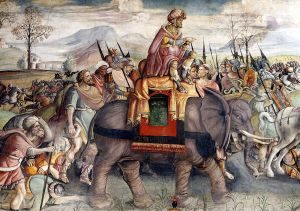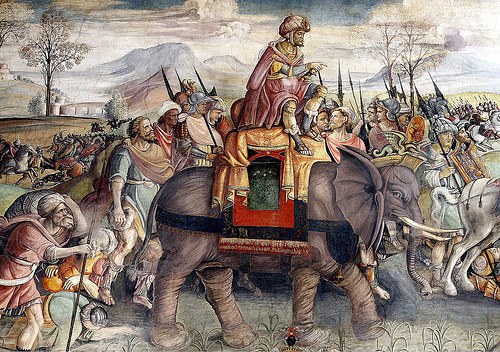
GOLDSCHMIDT CONFERENCE—Analysis of ancient Roman coins has shown that the defeat of the Carthaginian general Hannibal led to a flood of wealth across the Roman Empire from the silver mines of Spain. This finding, which gives us a tangible record of the transition of Rome from a regional power to an Empire, is presented at the Goldschmidt geochemistry conference in Paris.
The Second Punic War, where Hannibal famously marched his elephants across the Alps in a failed attack on Rome, has been regarded as one of the pivotal events of European history. Rome entered the war as the dominant power in Italy, but emerged an empire(1). The war led to the conquest of the Iberian Peninsula, with the Romans gradually gaining control over the lucrative Spanish silver mines from around 211 B.C. Revenues from the rich Spanish silver mines coupled with booty and extensive war reparations from Carthage, helped fund the expansion of its territory.
Now the application of geochemical analysis techniques has provided proof of the importance of the Spanish silver to the Roman conquest. A group of scientists based in Germany and Denmark and led by Prof Fleur Kemmers and Dr Katrin Westner (Institute for Archaeological Sciences, Goethe University, Frankfurt) analysed 70 Roman coins dating from 310-300 B.C. to 101 B.C., a period which bracketed the Second Punic War. Using Mass Spectrometry, they were able to show that lead in the coins made after 209 B.C. has distinctive isotopic signatures which identified most of the later coins as presumably originating from Spanish sources. The changing origin of the coin bullion is mirrored by differing ratios of the lead isotopes 208Pb, 207Pb, 206Pb and 204Pb, which serve as geological clocks recording the formation age of the ores used to extract the silver. After 209 B.C., the lead isotope signatures mostly correspond to those of deposits in southeast and southwest Spain or to mixtures of metal extracted from these districts.
“Before the war we find that the Roman coins are made of silver from the same sources as the coinage issued by Greek cities in Italy and Sicily(2). In other words the lead isotope signatures of the coins correspond to those of silver ores and metallurgical products from the Aegean region”, said Katrin Westner. “But the defeat of Carthage led to huge reparation payments to Rome, as well as Rome gaining high amounts of booty and ownership of the rich Spanish silver mines. From 209 B.C. we see that the majority of Roman coins show geochemical signatures typical for Iberian silver”.
“This massive influx of Iberian silver significantly changed Rome’s economy, allowing it to become the superpower of its day. We know this from the histories of Livy and Polybius and others, but our work gives contemporary scientific proof of the rise of Rome. What our work shows is that the defeat of Hannibal and the rise of Rome is written in the coins of the Roman Empire”
Commenting, Professor Kevin Butcher (Department of Classics and Ancient History, University of Warwick, UK) said:
“This research demonstrates how scientific analysis of ancient coins can make a significant contribution to historical research. It allows what was previously speculation about the importance of Spanish silver for the coinage of Rome to be placed on a firm foundation”.
_________________________________________
Hannibal Crossing the Alps; detail from a fresco ca 1510, Palazzo del Campidoglio (Capitoline Museum), Rome. José Luiz, Wikimedia Commons
______________________________________________________
Article Source: Goldschmidt Conference news release
______________________________________________________
The research was funded by the Volkswagen-Stiftung.
1. See Michael P. Fronda, Between Rome and Carthage: Southern Italy during the Second Punic War (2010), Introduction.
2. See Prof Fleur Kemmers and Dr Tom Birch “Coinage and the dynamics of power”
______________________________________________________
Receive 30 days free access to the popular new CuriosityStream lineup of documentaries on science, history, nature, and technology as a new Popular Archaeology premium subscriber.
___________________________________________
Travel and learn with Far Horizons.
____________________________________________
This richly illustrated issue includes the following stories: Recent findings shedding new light on the whereabouts of the remains of Philip of Macedon, father of Alexander the Great; how an archaeologist-sculptor is bringing bones of the dead back to life; archaeologists uncovering town life at the dawn of civilization; an exclusive interview with internationally acclaimed archaeologist James M. Adovasio about what makes the Meadowcroft Rockshelter prominent in the ongoing search for the first Americans; what archaeologists are finding at the site of the ancient city of Gath, the home town of the biblical Philistine giant, Goliath; and how scientists are redrawing the picture of human evolution in Europe. Find it on Amazon.com.








